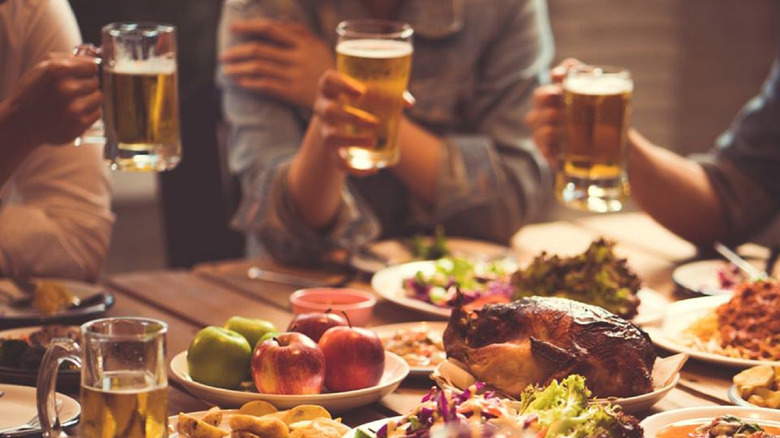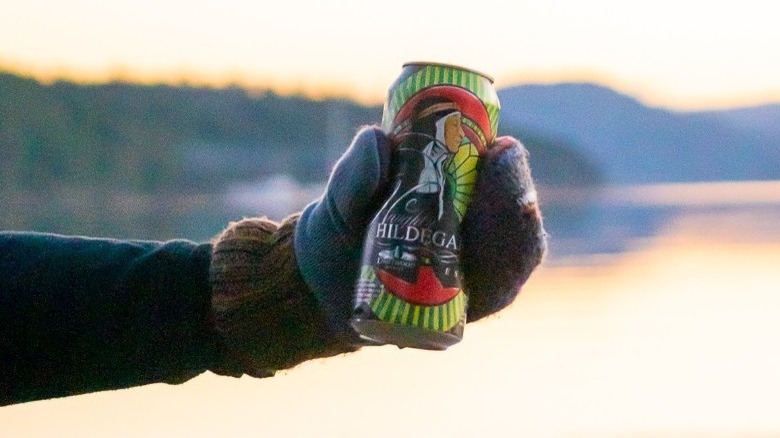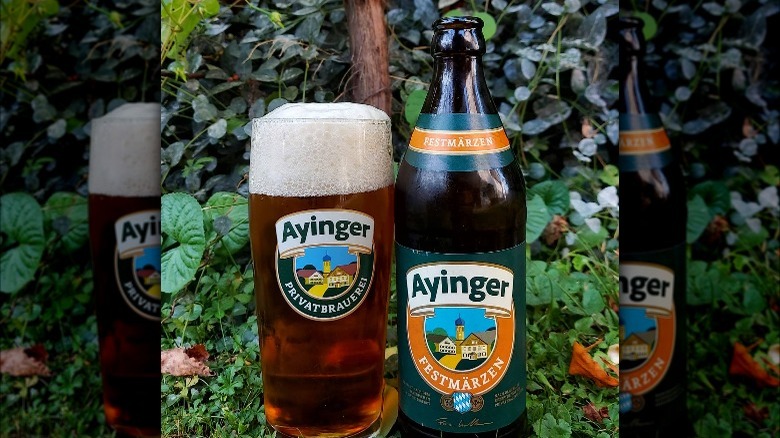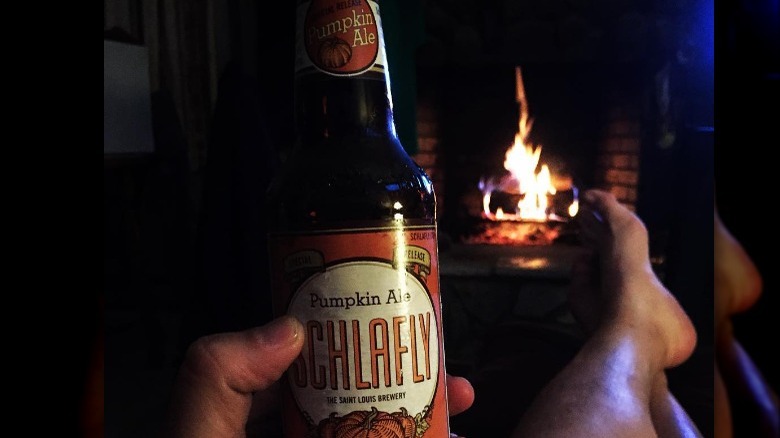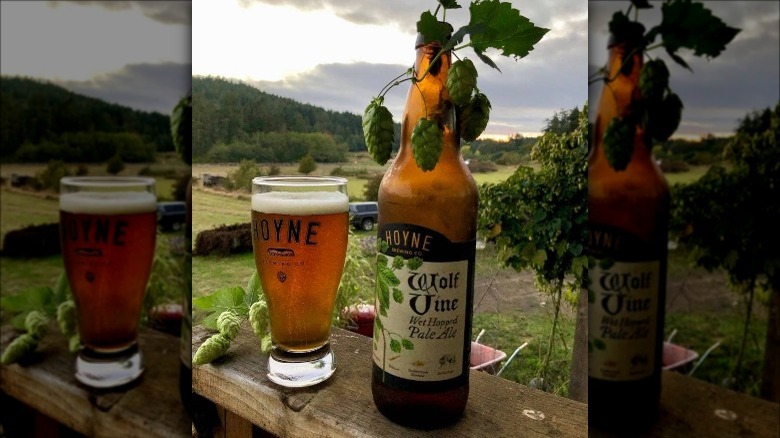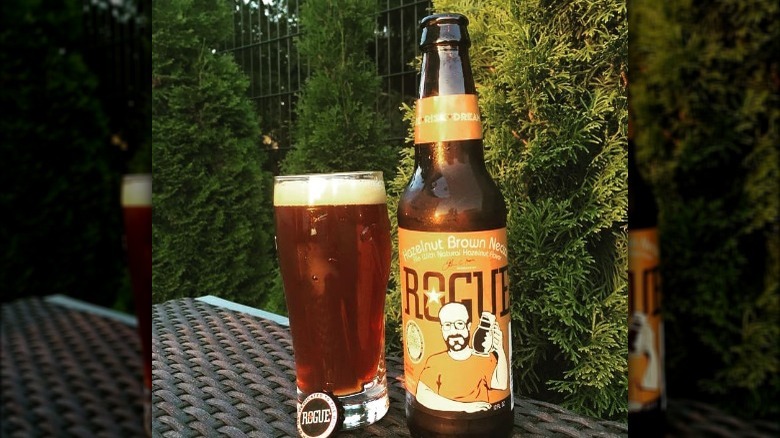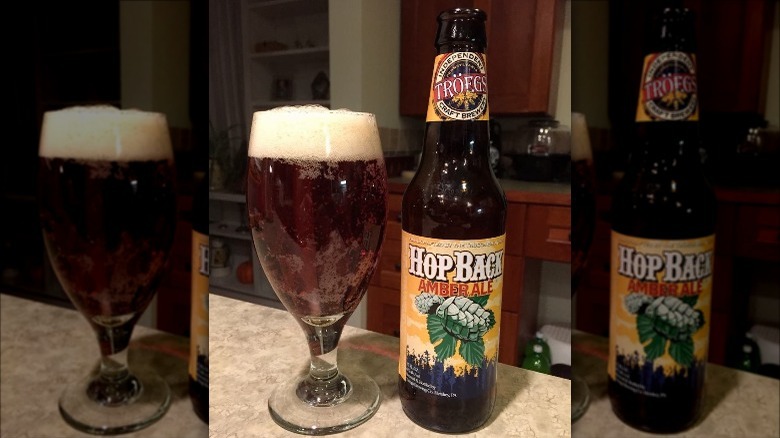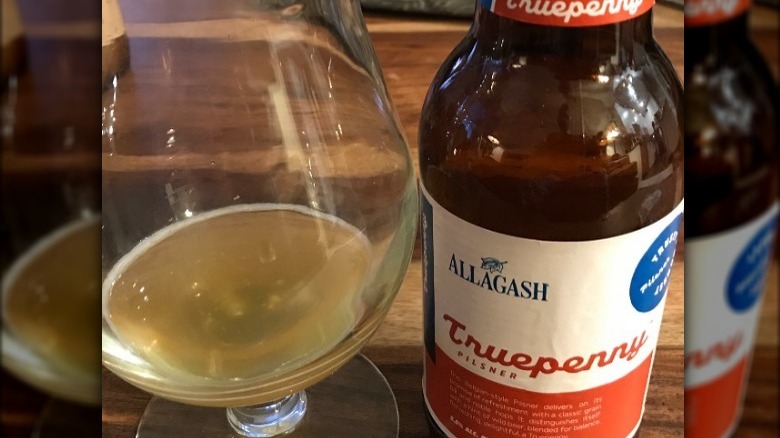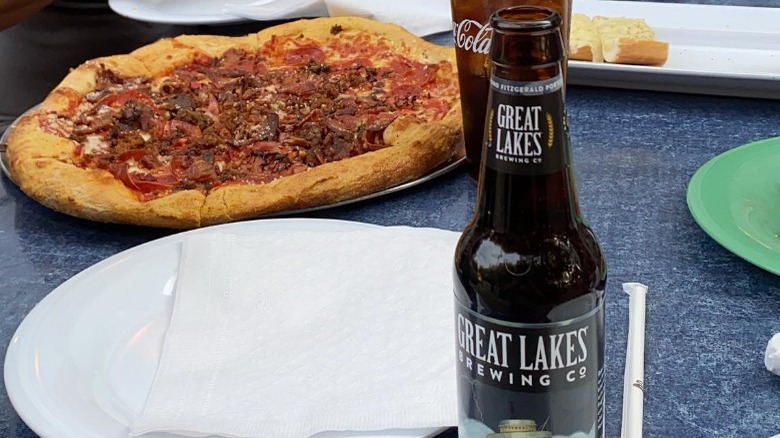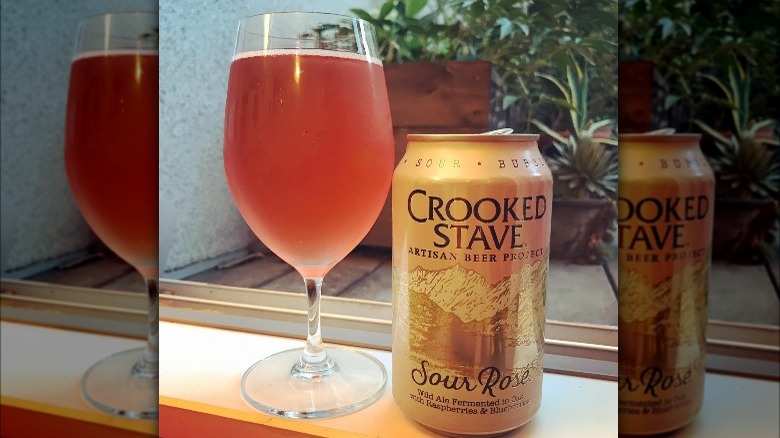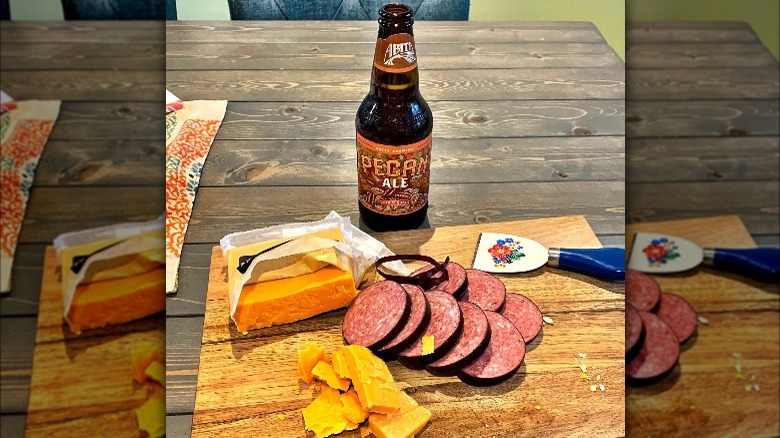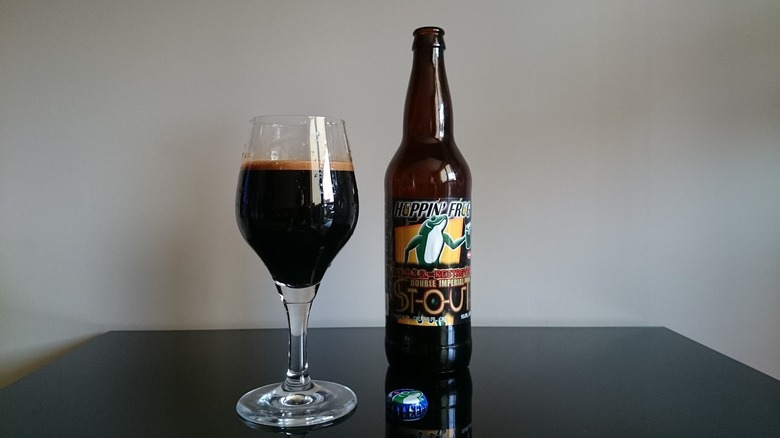10 Types Of Beer Perfect For Fall And Winter
A beer for every season and a season for every beer. As Deep Plate observes, when it's cold outside, people just want their drinks to warm them up. There's just something about the chillier months that demands warm comfort. As The Daily Gazette philosophizes, a light beer is nice after mowing the lawn, but after stacking firewood, you're going to want a hearty and "fuller-bodied" beer to revitalize your senses and keep them snug.
Fall and winter beers are often heavier brews that rely on spices to add further complexities to the brew's flavor profile. Autumnal beers are currently a little bit more in fashion, perhaps due to the highly popularized trends that dominate the chilly fall season, such as pumpkin spice-themed goodies and Oktoberfest.
But winter beers are really something in themselves as well. They're a bit heavier, a bit darker, and feature seasonal spices that are perfect for the coldest season of the year. These winter beers are perfect to hunker down with as the leaves begin to turn.
Driftwood Naughty Hildegard (Extra special bitter)
The Naughty Hildegard is a Pacific Northwest spin on an English classic. The beer is an ESB or an extra special bitter. ESBs are English pale ales, and this style of beer is the perfect meeting point between the sweet malt and the herbaceous yet earthy English hops (via Craft Beer). As apparent from its name, this beer is especially bitter.
English pale ale was refined in industrial England during the 1600s, when local ingredients like calcium sulfate-rich water and English malts built the modern profile of the drink (via Hop Culture). The yeast traditionally used for the ESB really brings the whole drink a beautiful and balanced floral finish.
This pale ale first really took off in popularity by the '30s and has since remained a much-beloved drink in England. There's good reason to incorporate this English drink into the roster. The American Naughty Hildegard takes the classic brew and adds a tropical twist of guava, mango, and citrus.
All the while, the beer gives a nod and wink to the medieval German mystic Hildegard von Bingen, who reported and popularized hop usage in brewing (via International Beer Fest). This beer offers the perfect transition between late summer and early fall. The Naughty Hildegard is packaged and sold in a can, which allows for easy transportation, making it ideal for, say, an autumnal camping trip.
Ayinger Oktober Fest-Märzen (Amber Rich Full Lager)
While the name Märzenbier may mean "March beer," this Bavarian delight is often served from September to October, specifically for Oktoberfest season (via Beer & Brewing). Märzenbier was once served at the (in)famous beer festival, and it is closely linked to the Oktoberfestbier, which is a specialty märzen-style beer
The märzen and the Oktoberfestbier have a lot in common: They both are lagers that use a Munich-specific malt, which gives both beers a highly aromatic profile. They both also have a golden amber color that is reminiscent of the beautiful golden fall!
As Bean to Barstool so succinctly describes, the real difference between Oktoberfestbier and märzen is that the latter is just "a little more." The märzen is just a little bit heavier, toastier, and intense. The drink is bound to carry a heavier punch, and while the two beers are similar, they should not be used interchangeably.
Märzens have become darlings of the craft beer community, so the Ayinger Fest-Märzen does well to go back to the source. The Ayinger brewery is located in a small town in Bavaria, and the Ayinger brewery provides the beer-loving regions with its most beloved beers (via Trip Advisor).
It's not surprising that the Ayinger Fest-Märzen is the stuff of dreams! This beer should be served in glass or earthenware and paired with some comforting foods like schnitzel or goulash.
Schlafly Pumpkin Ale (Pumpkin ale)
We'd be remiss to delve into fall to winter seasonal beers without including a pumpkin ale. While pumpkin beer might seem like it is related to the pumpkin spice lattes trend, the drink has a far more extensive history. According to a food historian interviewed in Mental Floss, pumpkins were a means of survival for early colonists in New England.
They were made of nutrient-dense and heavy produce that could sustain struggling colonists with few options through harsh winters. It wasn't long before the European colonists began, out of necessity, using pumpkins as fermenting material instead of grains in beer brewing. Pumpkin ales became stand-ins for beers in these colonies.
As food conditions in the colony improved, pumpkin ales all but faded into obscurity. It wasn't until the 1980s that the colonial brew was regenerated due to craft brewer Bill Owens. Since then, pumpkin ales have steadily increased in popularity.
Anyone who's eaten a pumpkin knows that these orange gourds don't have the brightest flavor and that pumpkin-based drinks often benefit from added spices. Pumpkin beers are available in a fairly wide range, from simple pumpkin ales to full-blown pumpkin spice beers.
Schlafly Pumpkin Ale is a wonderful mix of the ground pumpkin ale with hints of ginger, clove, caramel, and other fall spices. The brewer actually promises to deliver pumpkin pie in a bottle.
Hoyne Wolf Vine (Wet hopped pale ale)
International Beer Fest warns us not to overlook wet-hop beers in the vast landscape of seasonal beers: Hops are a bright green "acorn-like" plant that is often used to give the beer a more edgy, crisp, and bitter flavor. Hops were allegedly popularized in the 12th century, and they have long been used in brewing. Since hops are prone to wilting, different methods have been developed to deliver harvested hops to breweries, usually by drying them out.
However, fresh or "wet" hops can bring something special to beer brews. According to the site, the difference between dried and wet hops is like the difference between dried and fresh herbs. Wet-hop beers are broadly defined as having an earthy yet vegetal taste. Of course, there is a lot of variability within wet-hop beers due to the multiple different kinds of hops and harvests.
Hoyne Brewing Company's Wolf Vine Pale Ale is, by definition, an early fall beer, as its hops are harvested and brewed on one glorious day in September on Pender Island, which is off the coast of British Columbia. The beer is sold between September and October. According to the brewery, the beer effectively bottles the island's vivacity.
This specific wet-hopped pale ale is extremely hoppy and vegetal. It's available bottled as well as in a growler, although whichever form you purchase, just know that you're bringing a little bit of autumn back home with you.
Rogue Hazelnut Brown Nectar (Brown ale)
Brown ale is a style of English brew that can be traced back to the 1700s, according to Anchor Brewing. Brown ales were first used to refer to the better-known stouts and porters, and it wasn't until the 20th century that brown ales fully came into their own. Newcastle Breweries in Scotland reworked the older brown ale recipes and, most importantly, began selling bottles of its Newcastle Brown Ale, which proved to be an extremely strategic move: The brewery had successfully brought the notion of the brown ale back to the forefront of the conversation.
Today, as the brown ale has taken off, it can be classified into two distinct groups. According to Anchor Brewing, Northern brown ales tend to be lighter, often described with "nut" tones, and carry a slight yet sweet, malty flavor and aroma. On the other hand, London brown ales are darker, heavier, and more full-bodied. Who knows, maybe one day, Northern brown ales and London brown ales will become fully separate categories of beer altogether.
Not only is Rogue's Hazelnut Brown Nectar an extremely decadent name, but it's also a very innovative American twist on a European classic. The Hazelnut Brown Nectar originates from the U.S. hazelnut capital Oregon, and it combines a rich hazelnut aroma with a flavor. The beer finishes off like a classic brown ale, with a wonderful smooth maltiness. Hazelnut Brown Nectar makes the perfect addition to the Thanksgiving dessert table.
Tröegs HopBack (Amber ale)
Amber ale is just as brilliantly colored as autumn leaves! American amber ale is the American take on English pale ale, according to Craft Beer. The roasted malt that is used to make this beer not only gives the drink its amber hue but also a unique warm body and flavor that distinguishes this brew. Some say that amber ales have a warm, toffee-like flavor. American hops are also used in amber ales; they bring notes of citrus, fruit, and pine and add complexity to the sweetness of the drink.
This beer has such well-rounded and unique attributes that it's no wonder that it has become a beloved addition to the American drinking landscape. The Tröegs HopBack Amber Ale is a classic that has won multiple titles as the Mid-Atlantic's best amber ale. The Tröegs amber ale is especially hop heavy, and perhaps that's the secret to the drink's success. The hops add a pine-and-citrus twist to the caramel and toffee notes of this beer. Though amber ales are often served in bottles, they should be poured into a tulip glass and used to complement barbecue and seared meats.
Allagash Truepenny Pilsner (Belgian-style pilsner)
The Pilsner Urquell, often shortened to just "pilsner," shook the world after being developed around the late 19th Century in the Czech Republic (via Vine Pair). Pilsners are known for their refreshing quality, and Vine Pair even refers to the beer as "palate-rinsing" and "thirst-quenching." The classic Czech pilsner is a mild yellow and sweet, as well bready in nature with little to medium hop-presence. Since its creation, the pilsner has crossed country lines, and it also has German, American, and Belgian iterations.
The difference between the Czech and Belgian pilsner is very straightforward. Belgian pilsners are brewed with Belgian Lager Yeast, and they are quite hoppy in nature, according to Brewing with Briess. Allagash's Truepenny Pilsner is a Belgian-style pilsner from Portland, Maine. The New England brewery sticks to classic Belgian-style beers with malt grains and noble hops, but not without a twist.
The brewery often adds a hint of wild beer to the mix. Wild beer tends to add a funky twist in terms of flavor. The Truepenny Pilsner is a mix of both old and new worlds, and according to the Allagash brewery, it is bound to "refresh while it delights." It's available in cans and on draft, and Allagash recommends drinking the beer within 6 months of its brewing date.
Great Lakes Edmund Fitzgerald Porter (Porter)
It's worthwhile building a repertoire with the magnificent English porter beer; this lustrous beer was George Washington's favorite brew (via Just Beer App). Porters are one of the darkest beer varieties out there: They're so dark in color that they almost look black. Porters were first popularized during Industrial Revolution; brewers began centering their recipes around roasted brown malts, which gave the resulting porters a distinct dark color and rich flavor (via Delmarva Now).
Porters have more bark than bite. According to Delmarva Now, porters are "deceptively rich," and they are much more grounded than you might think. They are better characterized by the smoky taste from the roasted malts as well as a chocolatey bitterness. Porters are bitter in comparison to hop-ridden beers. It's these qualities that make porters a wonderful mid- to late-fall beer.
The Great Lakes Brewing Company delivers a wonderful drink in form of its Edmund Fitzgerald Porter. The company is a nationally and globally acclaimed porter, and the. brewer promises a "robust and complex" drink with unique bittersweet chocolate-coffee notes.
Porters are unique in that they're not as strong as other winter beers but not as crisp as earlier autumn beers. Porters are a beer that demands leisure and comfort. In that spirit, Great Lakes Brewing suggests pairing their porter with oysters and chocolate: Pure leisure.
Crooked Stave Sour Rosé (American wild ale)
The Crooked Stave Sour Rosé is the beer for those who aren't into beer, and it's sure to please even the most finicky of palates. The sour rosé makes for a pretty pink drink. Its golden rose coloring looks like the perfect mix between beer and wine.
But how exactly did these worlds collide? The answer is wild ale. Wild ales are one of the more experimental beer genres. They're described by Chatelaine as the "natural wines of the beer world" due to the wild yeasts that ferment the brew. These wild yeasts and bacteria give wild ales an extremely unique flavor profile, and it's not uncommon to find varieties like earthy, sour cherry, or bacon wild ales.
Simply put, wild ales are the funky frontier of the beer world. Crooked Stave's Sour Rosé is made by fermenting wild ale with raspberries and blueberries. This ale's flavor is not too funky, and the bright carbonation in this drink gives it an appealing sparkle. This sour rosé strikes a balance between sweet and sour; moreover, it has a pleasantly tart tang due to the raspberries.
Abita Pecan Harvest Ale (American brown ale)
Similar to the Hazelnut Brown Nectar, Abita Brewing Company's Pecan Harvest Ale is another Northern Brown Ale. As Brew Your Own describes, Northern English brown ales are slightly sweet malt-leaning brews that contain notes of nut, biscuit, and caramel. While there's a lot going on in this beer, none of it is overwhelming. The Northern English brown ale is all about striking the right chord. In comparison to its London (sometimes referred to as Southern) alternative, the Northern brown ale is drier and slightly more bitter
Abita's Pecan Harvest Ale is another regional American take on the brown ale that incorporates Louisiana pecans. As Beer Awareness aptly describes, this ale is a clear "American take" on the European beer, with just a little hint of "something extra." This "something extra" is the brew's use of actual toasted pecans: Many brown ales simply do not use real nuts in their brews.
Beer Awareness also observes that the pecan's natural oils enhance the pecan flavors of the beer; additionally, the whiffs and flavor of caramel and biscuit play nicely with the nuttiness of the drink. This beer can be paired with pub fare such as burgers and buffalo wings, though pecan ale works just as well with charcuterie boards.
Hoppin Frog D.O.R.I.S. The Destroyer (Imperial stout)
The Imperial Stout might have originated in Imperial Russia, but it has gained a lot of traction in England; it faded from the mainstream until it was picked up by the American craft beer movement: That's a lot of movement for one style of beer. Stouts are heavy beers, and according to Delmarva Now, they're quite strong and smoky. These beers are perfect for slow, measured sipping.
American Imperial stouts are notably more bitter than their predecessors, although, as Craft Beer Club notes, they possess a "luscious" texture, despite the inherent bitterness. Imperial stouts have a higher alcohol content, and American Double Stouts are the strongest of the genre; the ABV for these beers can go up to 13%.
Typically, American Double Stouts are special releases. The Hoppin' Frog Brewery of Akron, Ohio, offers the heavily-named D.O.R.I.S The Destroyer, which is a bourbon barrel-aged double imperial stout.
But, if any beer has earned such a name, it's this complex beer. D.O.R.I.S is an acronym for Double Oatmeal Russian Imperial Stout. This barrel-aged beer is heavy and quite hoppy. The Bourbon barrel aging adds a savory yet vanilla-like character to the beer. If you're looking for a beer to spend a winter evening with, then this is the perfect one!
